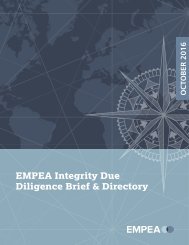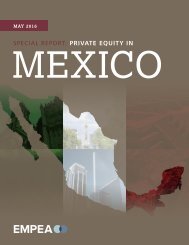Create successful ePaper yourself
Turn your PDF publications into a flip-book with our unique Google optimized e-Paper software.
Human <strong>Capital</strong><br />
Instrumental Factor Source Website<br />
Citizens Domestic Purchasing Power<br />
UBS<br />
http://www.ubs.com/1/e/ubs_ch/wealth_<br />
mgmt_ch/research.html<br />
R 2 = 0.179 City Based Public Sector Influence = Medium Private Sector Influence = Low<br />
This indicator measures the purchasing power <strong>of</strong> the citizens <strong>of</strong> 73 cities across the world. It is based on average earnings per city and a general basket<br />
<strong>of</strong> 154 goods and services based on Western European consumer preferences. Higher purchasing power implies a better standard <strong>of</strong> living and quality<br />
<strong>of</strong> local services available.<br />
Citywide CO 2 Emissions Carbon Disclosure Project http://www.cdpcities2013.net/#!/index/<br />
R2 = 0.209 City Based Public Sector Influence = Medium Private Sector Influence = Medium<br />
As measured by CDP—an international, not-for-pr<strong>of</strong>it organisation providing a global system for companies and cities to measure, disclose, manage<br />
and share vital environmental information. CDP holds a very extensive collection <strong>of</strong> primary climate change, water and forest-risk information.<br />
Global Talent Index<br />
EIU<br />
http://www.managementthinking.eiu.com/<br />
global-talent-index-2011-2015.html<br />
R 2 = 0.135 Country Based Public Sector Influence = Medium Private Sector Influence = Medium<br />
This index presents an outlook to 2015 for countries’ talent development, attraction and retention potential. It gauges talent trends on two dimensions:<br />
at the international level through a benchmarking index <strong>of</strong> talent environments in 60 countries; and at the enterprise level, determining how executives<br />
view the outlook for their own firms’ ability to attract and retain the people they will need. The index is based on data in seven categories: Demographics;<br />
Compulsory education; University education; Quality <strong>of</strong> the labour force; Talent environment; Openness and Proclivity to attracting talent.<br />
Human <strong>Capital</strong><br />
EIU<br />
http://www.economistinsights.com/<br />
countries-trade-investment/analysis/hotspots/<br />
R 2 = 0.115 City Based Public Sector Influence = Medium Private Sector Influence = Medium<br />
Human <strong>Capital</strong> is one <strong>of</strong> eight categories used in the Global City Competitiveness Index. It is made up <strong>of</strong> six sub-indices: population growth; workingage<br />
population; entrepreneurship and risk-taking mindset; quality <strong>of</strong> education; quality <strong>of</strong> healthcare and hiring <strong>of</strong> foreign nationals. It is an aggregate<br />
economic view <strong>of</strong> the human being acting within an economy. It looks at the combination <strong>of</strong> knowledge, creativity and personal attributes that are likely<br />
to contribute to economic performance—superior human resources are correlated with improved financial returns and increased shareholder value.<br />
Spatial Adjusted Liveability Index<br />
EIU<br />
http://pages.eiu.com/rs/eiu2/images/<br />
EIU_BestCities.pdf<br />
R2 = 0.125 City Based Public Sector Influence = Medium Private Sector Influence = Low<br />
This index examine spatial qualities such as the amount <strong>of</strong> green space and urban sprawl, the levels <strong>of</strong> pollution and cultural assets in concert with the<br />
categories used in the existing EIU Liveability index in order to incorporate spatial characteristics <strong>of</strong> the cities already present in the index. The initial<br />
liveability survey weighed up 30 factors, which broadly corresponded to five categories—including social stability, infrastructure, education and culture.<br />
Top Tourism Destinations<br />
Euromonitor Archive<br />
R 2 = 0.170 City Based Public Sector Influence = Medium Private Sector Influence = Low<br />
http://blog.euromonitor.com/2014/01/<br />
euromonitor-internationals-top-citydestinations-ranking.html<br />
This ranking <strong>of</strong> cities is comprised <strong>of</strong> the number <strong>of</strong> international arrivals over a year. It is estimated that around 80% <strong>of</strong> these arrivals are tourists but<br />
there is also an ever more important part – the MICE (Meetings, Incentives, Conventions and Exhibitions) travellers. International top tourist destinations<br />
have a powerful incentive to invest in travel infrastructure, hotels and convention centres and thus improve the overall quality <strong>of</strong> living and working there.<br />
http://www.uk.capgemini.com/thought-<br />
Number <strong>of</strong> High Net Worth Individuals<br />
Capgemini<br />
leadership/world-wealth-report-2013-from-<br />
capgemini-and-rbc-wealth-management<br />
R2 = 0.161 Country Based Public Sector Influence = Medium Private Sector Influence = Medium<br />
This factor represents the number <strong>of</strong> high net worth individuals per country as estimated by City Bank and Knight Frank’s latest Wealth Report. There<br />
are two implications behind the presence <strong>of</strong> more high net worth individuals in a country: first there will be more demand for financial services as<br />
wealthy people will need private banking, asset management, insurance services, etc; second the country will be a relatively good place to live in.<br />
<strong>Conduits</strong> <strong>of</strong> <strong>Capital</strong> – Onshore Financial Centres and Their Relevance to African Private Equity<br />
| 147





